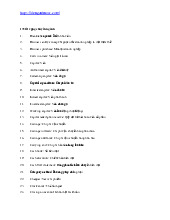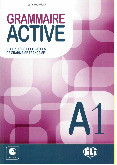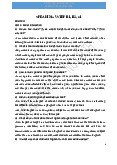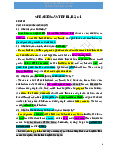


















Preview text:
Politeness in communication in English and Vietnamese cultures
An intercultural communication study of Quy Nhon University By Huong Dung Nguyen
A thesis composed by Huong Dung Nguyen in compliance with the
requirements for the degree of PhD University of Quy Nhon
I. NOTION OF POLITENESS··········································································3
1. Definition····················································································3
2. Principles, maxims and strategies regarding politeness in
communication···············································································4
2.2.Conversational Principle·····················································4
2.2.1.Co-operative Principle·····················································4
2.1.1.1. Maxim of quantity·······················································5
2.1.1.2. Maxim of quality··························································5
2.1.1.3. Maxim of relation························································5
2.1.1.4. Maxim of manner························································6
2.2.2.Conversational Implicature··············································6 2.3.
Politeness Theory···························································7 2.3.1.
Face···························································7
2.3.2.Face Threatening Acts (FTAs)···········································7
2.3.3.Positive Politeness and Negative Politeness····················7
2.3.4.Politeness Strategies························································7
2.4.Conversation Maintenance ················································8
2.4.1.The Conversation Maintenance’s definition····················8
2.4.2.The functions of Conversation Maintenance··················8
3. Politeness Strategies···································································8
3.1. Positive Politeness Strategies············································8
3.1.1. Attention to H (his/her needs and interests .etc)···········8
3.1.2. Seek agreement······························································9
3.1.3. Use In-group Identity Marker·········································9
3.1.4. Presume/Assert S’s awareness of and concern for H’s
wants························································································9
3.1.5. Presume/Assert common ground··································9
3.1.6. Avoid disagreement······················································10
3.2. Negative Politeness Strategies·········································10
3.2.1. Apologize······································································10
Insinuating impingement··················································10
Insinuating hesitation························································10
Begging forgiveness···························································10
3.2.2. Minimize the Imposition···············································11
3.2.3. Hedge············································································11
3.2.4. Provide Deference························································11
II. POLITENESS IN VIETNAMESE AND ENGLISH CULTURES·······················11
1. Politeness in Vietnamese culture·············································11
1.1. Displays of Politeness······················································12
1.1.1. Respect·········································································12
1.1.2. Smile·············································································12
2. Politeness in English - American culture···································13
2.1. Greeting etiquette···························································13
2.2. Appropriate use of first names········································14
3. Similarities and differences·······················································14
3.1. Similarities·······································································14
3.2. Differences·······································································14
III. CONCLUSION·······················································································15
REFERENCE·······························································································16 I. NOTION OF POLITENESS 1. Definition
Watts in the introduction to “Politeness in language” (1992:3) makes a
distinction between two types of politeness: first-order and second-order.
First-order politeness conforms to “…the various ways in which polite behavior
is perceived and discussed by members of socio-cultural groups. It
incorporates, to put it succinctly, common sense notions of politeness.
Second-order politeness, on the other hand, is a theoretical construct which
exists within a theory of social behavior and language usage.”
In regards of first-order politeness, data suggests words or notions
which refer to proper social conduct and norms of appropriate social behavior
in ordinary language use in all cultures and languages. Which implies what
counts as polite behavior is relative to a specific culture, a small-scale speech
community or even a dominant social class within a society.
In English, according to Kasper (1994: 3206), ‘polite’ dates back to the
fifteenth century ‘polished’. In the seventeenth century, a polite person was
defined as having ‘refined courteous manners’ (The Oxford Dictionary of
Etymology). As a result, politeness affiliated with the behavior of the upper
classes. In modern day usage, ‘polite’ is defined as “having refined manners,
courteous; cultivated, cultured; well-bred; refined, elegant” (The Oxford
Learner’s Dictionaries).
It is stated by Lakeoff (1973: 297-298) that “ Politeness usually
supersedes: it is considered more important during a conversation to avoid
offence than to realize clarity. This makes sense, since in most informal
conversations, actual communication of important ideas is secondary to
merely reaffirming and strengthening relationship.” This notion helped
formulate two rules of pragmatic competence: (1) Be clear (2) Be polite 2.
Principles, maxims and strategies regarding politeness in communication 2.2.
Conversational Principle
2.2.1. Co-operative Principle
The cooperative principle describes how people normally carry
themself during a conversation. The cooperative principle was divided by Grice
into four maxims which were called Gricean maxims including maxim of
quality, maxim of quantity, maxim of relation, maxim of manner. 2.1.1.1. Maxim of quantity
Also known as maxim of content length and depth. In simple terms, the
maxim of quantity is to be informative. Submaxims:
Make your contribution as informative as is required (for the current purposes of the exchange).
Do not make your contribution more informative than is required.
In his book, Grice uses the following analogy for this maxim: "If you are
assisting me to mend a car, I expect your contribution to be neither more nor
less than is required. If, for example, at a particular stage I need four screws, I
expect you to hand me four, rather than two or six. 2.1.1.2. Maxim of quality
Also known as maxim of truth. In other words, the maxim of quality is to be truthful. Supermaxim:
Try to make your contribution one that is true. Submaxims:
Do not say what you believe is false.
Do not say that for which you lack adequate evidence.
In his book, Grice uses the following analogy for this maxim: "I expect
your contributions to be genuine and not spurious. If I need sugar as an
ingredient in the cake you are assisting me to make, I do not expect you to
hand me salt; if I need a spoon, I do not expect a trick spoon made of rubber." 2.1.1.3. Maxim of relation
Also called maxim of relevance. In his book, Grice uses the following
analogy for this maxim: "I expect a partner’s contribution to be appropriate to
the immediate needs at each stage of the transaction. If I am mixing
ingredients for a cake, I do not expect to be handed a good book, or even an
oven cloth (though this might be an appropriate contribution at a later stage)."
With respect to this maxim, Grice writes: “Though the maxim itself is
terse, its formulation conceals a number of problems that exercise me a good
deal: questions about what different kinds and focuses of relevance there may
be, how these shift in the course of a talk exchange, how to allow for the fact
that subjects of conversations are legitimately changed, and so on. I find the
treatment of such questions exceedingly difficult, and I hope to revert to them in later work.” 2.1.1.4. Maxim of manner
In simple terms, the maxim of manner is to be clear.[7] [8] [9] Whereas
the previous maxims are primarily concerned with what is said, the maxims of
manner are concerned with how what is said is said.[9] Supermaxim: Be perspicuous. Submaxims:
1. Avoid obscurity of expression — i.e., avoid language that is difficult to understand. 2.
Avoid ambiguity — i.e., avoid language that can be interpreted in multiple ways. 3.
Be brief — i.e., avoid unnecessary prolixity.
4. Be orderly — i.e., provide information in an order that makes sense, and
makes it easy for the recipient to process it.
2.2.2. Conversational Implicature
“Conversational Implicature” insinuates either (I) the act of meaning,
implying, or suggesting one thing by saying something else, or (II) the object of
mentioned act. Implicatures are often a part of sentence meaning or
dependent on conversational context, and can be conventional (in different senses) or unconventional. 2.3. Politeness Theory 2.3.1. Face
“Face” which is defined as “the public self-image that each and every
member (of society) need to assert for oneself”. Face consists of two related
aspects: negative face and positive face.
2.3.2. Face Threatening Acts (FTAs)
A face-threatening act (FTA) is an act which challenges the face wants of
an interlocutor. In consistent to Brown and Levinson (1987), face-threatening
acts may threaten either the speaker’s face or the hearer’s face, and that they
may threaten either positive face or negative face: (A) Acts threatening to the
hearer’s negative face, (B) Acts 10 threatening to the hearer’s positive face, (C)
Acts threatening to speaker’s negative face, (D) Acts threatening to speaker’s positive face.
2.3.3. Positive Politeness and Negative Politeness
Positive Politeness is concerned with other people’s need for
admittance and social consent. It is used for driving the hearer to feel good
about himself/herself, his/her interests or possessions and are mostly utilized
in situations where the audience knows one another adequately well.
Negative politeness deals with other people’s need not to be overstepped or imposed upon.
2.3.4. Politeness Strategies
The bald on-record strategy does nothing in order to attenuate threats
to the hearer's “face”. . The positive politeness strategy confirms that the
connection is friendly and expresses group reciprocity. . The negative
politeness strategy assume that you could also simply be imposing on the
hearer, and intruding on their space. . Off-record indirect strategies alleviate
some of the pressure off of the hearer. By using this strategy, the speaker are
removing himself/herself from any imposition whatsoever. 2.4.
Conversation Maintenance
2.4.1. The Conversation Maintenance’s definition
The study is based on the following viewpoints on conversational maintenance
by Geddes et al. [25, p.13]: “To encourage conversation, it is important to be a
good listener as well as a good speaker. When we are listening, we can show
our interest nonverbally by nodding our heads, raising our eyebrows, laughing,
and so on. We can show our interest verbally such as making a comment,
asking a short question, repeating a keyword or phrase, and so on.”
2.4.2. The functions of Conversation Maintenance
There exist several viewpoints about conversation maintenance that
have contributed greatly to our study. However, one particularly prominent
viewpoint is that of Olson [75], in “Content for Conversation Partner”, which
affirms that strategies of conversational maintenance can improve learners’
communicative proficiency during conversation. The atmosphere in which
many participants of different voices enthusiastically converse will make students progress. 3. Politeness Strategies 3.1.
Positive Politeness Strategies
3.1.1. Attention to H (his/her needs and interests .etc)
Keeping an eye on people’s wants or needs is an effective way to leave
good impression on them, which, in turn, makes starting and maintaining
conversations almost effortless.
Krau: I’m impressed. That’s a beautiful motorbike you got there! Wife: Wow! Em c m ả n.
ơLâu lắắm rồồi em khồng ắn bún đ u. ậ Anh vâẫn
nh là em thích món này hay th ớ t. ậ 3.1.2. Seek agreement
By employing this, S should foremost figure out topics that both
participants interested in talking about prior to diving into deeper, more vivid
conversations. The safest topics commonly utilized to create intimacy is about the weather
Thresh: Look at the clouds gathering. It seems a rain is coming. And a
heavy one, by the look of it.
3.1.3. Use In-group Identity Marker
These “Markers” include names and terms of address that are
commonly used such as: Mate, bud, pal, honey, sweetheart, cutie, etc.
Teacher: Alright, kids. Any questions? If no, class dismissed.
Nam: Nay cồng vi c nhiềồu lắắm hay sao mà bé yề ệ u c a anh b ủ ph ơ v ờ y? ậ
3.1.4. Presume/Assert S’s awareness of and concern for H’s wants
S can may hint his/her care for H’s desires and, in so doing, compels H to work in concert with S.
Group leader: There’s no need to be formal in this meeting. I know
everyone won’t mind if you all want to ask questions as we proceed. Qu ng: C ả tho ứ
i mái đi. Em biềắt anh muồắn nói gì mà. ả
3.1.5. Presume/Assert common ground
This is how S spends time and effort on befriending H. There are three
approach to this: Idle chatter, Syntactic Questions and Cajolers (You know/see,
As I was saying, As you may have guessed, etc.)
Lawyer: It’s excellent. You see, Johnny, I have formulated a compelling
argument that will definitely elevate our case in the court tomorrow.
Bình: Em cũng thâắy rồồi đó. Nhà c a ử thì ch t ch ậ i mà anh l ộ i muồắn t ạ i ụ
mình sồắng thoả i mái hơ n t. Mình nền chuy n nhà thồi. ể
3.1.6. Avoid disagreement
In order not to be offensive, it is important that this S employ this
strategy to mitigate the threat. Additionally, this strategy can be used
deliberately to agree in pretend or to hide disagreement.
Janice: Good thinking, but shouldn’t we go through others options in
case things don’t turn out the way we want?
Tào Tháo: Nhân t quá rồồi, nh ừ
ư ng đó mớ i là cá tnh c a quân s ủ . ư 3.2.
Negative Politeness Strategies 3.2.1. Apologize
By doing this in order to prolong the conversation, S may hint that
he/she actively avoid intruding upon H’s negative face.
Insinuating impingement
Jack: Will, buddy. I’m well aware that you are busy with your own work
but I’d be immensely grateful if you could spare some time and help me with this project.
Insinuating hesitation
Elliot: I don’t wish to be brash but we must consider the possibility that
Derek is in harm’s way since there has been no sign of him for weeks
Nguyền: Tao h i cái này nó h ỏ i bâắt l ơ ch s ị nh ự ng mà sao mày v ư i ng ớ i ườ
yều chia tay vậy Duy? Begging forgiveness
S: I beg your pardon, miss. May I have a moment of your time, please? Vi t Anh: Hay đâắy! T ệ
ớ thích sự vui tnh c a c ủ u. Th ậ lồẫi mình h ứ i tò ơ mò nhưng b n h ạ c tr ọ ường nào v y? ậ
3.2.2. Minimize the Imposition
Lessen the gravity of the Imposition is an excellent way to refrain from
coercing H. In English, this include phrases such as: a wee little, a tiny bit, just,
only, etc. In Vietnamese, there are: mộ t chút, mộ t t, mộ t ít, mộ t tẹ o, t xíu nữa, etc. 3.2.3. Hedge
In maintaining a conversations, this is used when H requires a
clarification from S without coercing him/her. Hedging expression includes but
not limits to: “I wonder” in English or “Có ph i…khồng ta? ả ” in Vietnamese.
Lucius: One more thing, Mr. Wayne. I wonder how is the car performing
to your high expectations? Cường: a v Ụ y thì có ậ ph i ả đo n mã này ạ quy đ nh cách ị mà ch ng trình ươ lưu d li ữ ệu ng i dùng nh ườ p vào t ậ bàn phím khồng ừ ta?
3.2.4. Provide Deference
In addition to expressing his/her respect and humility, S may seek to
satisfy H’s desires to be treated as superior, even more so in cases when the
latter is of a higher social standing than that of the former.
Benjamin: I’m afraid I don’t quite understand what you mean, sir. B o vả : Anh c ệ g t chồắng x ứ ạ
uồắng xe đ em dắắt cho. ể
II. POLITENESS IN VIETNAMESE AND ENGLISH CULTURES
1. Politeness in Vietnamese culture
The Vietnamese people value modesty and humility as well as
harmonious relations with others. Seeking to avoid conflict in relationships,
they often prefer to speak about sensitive subjects indirectly. Traditionally,
Vietnamese people list their family name first, then their middle name, with
their first (given) name listed as last. Family members use different given
names (first names aren’t passed down), and the name reflects some
meaning. Some names can be used for either gender.
Vietnamese culture seriously concerns with status (obtained with age
and education). The Vietnamese sometimes appear to answer “yes” (d ) to ạ all
questions. However, the way of saying yes is quite polite “Yes, I am listening,”
“Yes, I am confused,” or “Yes, I do not want to offend.” “Thua” (meaning
please) is added in front of the first name to show respect. 1.1. Displays of Politeness 1.1.1. Respect
The respect is the corner-stone of interpersonal relationships in
Vietnamese society. Normally, respect is conveyed by the use of special terms
of address and certain stylistic devices. Yet, it is also expressed by nonverbal
behavior. For example, a Vietnamese student who sits quietly and listens
attentively to the teacher wants to express respect to his teacher. This
behavior has often been misinterpreted by the American teacher as passivity and non-responsiveness.
It is also out of respect that the Vietnamese student avoids eye
contact with his teacher when speaking or being spoken to. By American
standards, a person acting in this way would appear suspicious, unreliable, or
mischievous. In Vietnamese culture, however, looking into somebody’s eyes
usually means a challenge or an expression of deep passion. 1.1.2. Smile
The smile, which is sometimes enigmatic to the American observer, is
another nonverbal symbol conveying the feeling of respect in Vietnamese
culture. It should be noted that for certain feelings, Vietnamese culture prefers
non-verbal communication while American culture is more inclined to use
verbal expression. It is used as an expression of apology for a minor offense,
for example, a late coming to class or an expression of embarrassment when
committing an innocent blunder. For the Vietnamese, the smile is a proper
response in most situations when verbal expression is not needed or not
appropriate. It is used as a substitute for “I’m sorry“, “Thank you” or “Hi!”
instead of a ready yes to avoid appearing over-enthusiastic. 2.
Politeness in English - American culture
Politeness is woven into the traditions and customs of every culture in
the world. So, if you’re travelling there or moving to another country, it’s
important to understand how that culture understands politeness in order to
lessen the chance of misunderstandings and causing offense.
Following that same concept, politeness is an integral part of English -
American culture. We put a heavy weight on first impressions and how we
view someone later on if the first impression doesn’t go so well. Furthermore,
politeness is an important form of daily communication, whether that be at
work, at the doctor’s office, or even walking down the street. How suitably
polite you are heavily influences your job prospects, your ability to make
friends, and how comfortable you’ll be while in America when interacting with others. 2.1. Greeting etiquette
The same as with other cultures, greetings can also be used to convey
politeness in America. The important thing to remember here is which
gestures are appropriate. Most often greetings involve a hug or handshake, so
I’ve outlined some example situations to clarify: When to hug:
When you’re a guest at someone’s home
Meeting friends for dinner or another informal activity
Meeting colleagues (that you know) outside of work and sometimes even at work When to shake hands: Job interviews Meetings with supervisors
Formal appointments (such as with a doctor, professor, lawyer, or executive)
When greeting a stranger outside of home in public
In addition to this, it’s important to note that Americans never greet with kisses. 2.2.
Appropriate use of first names
The US people has a highly informal culture and prefer to call each
other by their first names. In college, students even referred to our head
professor by her first name, so this is how far it extends. A similar concept
goes for the workplace as well (unless you have a particularly hierarchical
structure, but here you can base your behaviour on other colleagues). 3.
Similarities and differences 3.1. Similarities
There are certain resemblances when it comes to utilizing positive
politeness strategies in speaking which the most favored ones include
“Attention to H” and Presume/ “
Assert common ground”. On the other hand,
“Hedge” strategy is the most inclined toward in negative politeness.
All mentioned politeness strategies for starting and maintaining
conversations are predominantly dictated by social factors, including sexes,
social standing, which are commonly available in both English and Vietnamese cultures. 3.2. Differences
English speakers tend to use more in-group identity markers than Vietnamese.
The Vietnamese, in contrast, outpace the English in the frequency of
using “Minimizing the Imposition” and “ ”
Apologize strategies, particularly
between lower to higher social status. In addition, Vietnamese speakers take
more “Avoid Disagreement” than English ones.
“Provide Deference” are more heavily employed by the English than the
Vietnamese. Besides, there is a great difference in the use of “Hedge”
between English and Vietnamese people. III. CONCLUSION
The main focus of the description and analysis of politeness tactics for
moving a conversation in the two languages is pragmatics. However, cultural
and social factors influence how politeness methods are chosen. The
information reveals some parallels and differences between English and
Vietnamese. In terms of commonalities, both groups choose positive
politeness tactics in communicating in certain situations. When it comes to
disparities, English and Vietnamese women employ more negative politeness
methods in speaking than men, whereas men listen with greater sympathy
than women. The outcome indicates the considerable influence of each
group's culture and social circumstances on how they use politeness methods.
The end result should enable persons from both languages avoid
embarrassment, confusion, and surprise when communicating. Language
learners will benefit from the research because they will be able to overcome
some difficulties in continuing a conversation, enhance their conversational
fluency, and increase their pragmatic, cultural, and social awareness when learning a foreign language. REFERENCE
1. Leech, Geoffrey. "Politeness: Is there an East-West divide?" , vol. 3, no. 2,
2007, pp. 167-206. https://doi.org/10.1515/PR.2007.009 2. https://files.eric. ed.gov/fulltext/ED140617.pdf
3. LAKOFF, ROBIN TOLMACH. "The limits of politeness: therapeutic and
courtroom discourse" , vol. 8, no. 2-3, 1989, pp. 101-130.
https://doi.org/10.1515/mult.1989.8.2-3.101 4. https://book s.google.com.vn/books?
hl=en&lr=&id=cCyTAwAAQBAJ&oi=fnd&pg=PP1&dq=leech+politeness+
principle&ots=QN_3LMdEy_&sig=vFgPO7Hg5g2fAIHeOnKf5wFcLXc&red
ir_esc=y#v=onepage&q=leech%20politeness%20principle&f=false 5. https://book s.google.com.vn/books?
hl=en&lr=&id=sR86AAAAQBAJ&oi=fnd&pg=PR1&dq=lakoff+politeness&
ots=mNcQJFx126&sig=lSG6MQsoo7YigZUe5kp-
eAGzhyk&redir_esc=y#v=onepage&q=lakoff%20politeness&f=false
Part II. Point out the politeness strategies employed in the following conversation: "Lão c i và ho sòng s ườ
c. Tồi nắắm lâắy cá ọ
i vai gâồy c a lão,ồn t ủ ồồn b o: - ả
Ch ng kiềắp gì sung s ẳ ng th ướ t, nh ậ
ng có cái này là sung s ư ng: bây gi ướ c ờ ụ
ngồồi xuồắng ph n này ch ả i, tồi đi lu ơ c mâắy c ộ khoai lang, nâắu m ủ t âắm ch ộ ờ t i th
ươ t đậc; ồng con mình ắn khoai, uồắn ặ g n
c chè, rồồi hút thuồắc lào... ướ Thềắ là s ng".. ướ
Vâng! Ông giáo d y ph ạ i ! Đồắi v ả
i chúng mình thì thềắ là sung s ớ ng. ướ
Nói xong lão l i cạ i đ
ườ a đà. Tiềắng c ư i g ườ ng nh ượ
ng nghe đã hiềồn h ư u ậ l i. T ạ ồi vui v b ẻ o: ả - Thềắ là đ c, ch ượ gì? V ứ
y cậ ngồồi xuồắng đây ụ
, tồi đi lu c khoai, nâắu n ộ c. ướ
- Nói đùa thềắ, ch ồng giáo đ ứ cho khi khác. ể - Vi c gì còn ph ệ i ch ả
khi khác?... Khồng bao gi ờ nền hoãn s ờ sun ự g s ng ướ
l i. Cạ c ngồồi xuồắn ụ ứ
g đây! Tồi làm nhanh lắắm…
- Đã biềắt nh ng tồi còn muồắn nh ư ồng m ờ t vi ộ ệc…
M t lão nghiềm trang l ặ i. ạ - Vi c gì thềắ c ệ ? ụ
- Ông giáo để tồi nói…. Nó hơ i dài dòng mộ t t. - Vâng, c nói. ụ
- Nó thềắ này, ồng giáo ! ạ (Nam Cao – Lão H c) ạ Bài làm
1. Vâng! Ông giáo dạy ph i
ả ! Đốối v i chúng mình t ớ hì thếố là sung s ng. ướ
Strategy 5: Seek agreement (Positive – Repetition)
2. Thếố là đ c, ượ ch gì? ứ
Strategy 2: (Negative – Question, hedge) 3. Vậy c
ụ ngồồi xuồống đây, tối đi luộc khoai, nâốu nước. Strategy 5:
(Positive – Repetition)
4. Nói đùa thếố, ch ống giáo ứ
để cho khi khác. Strategy 10: (Positive – Offer, promise) 5. Vi c gì còn ph ệ
ải ch khi khác?... Khống bao gi ờ nế ờ n hoãn sự sung s ng ướ l i. C ạ c ụ ngốồi xuốống đâ ứ
y! Strategy 11: (Positive – Optimistic)
6. Tối làm nhanh lắốm… Strategy 2: (Positive – Exaggerate)




